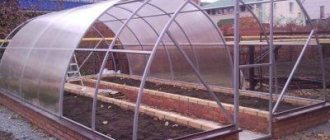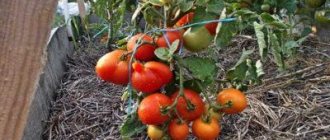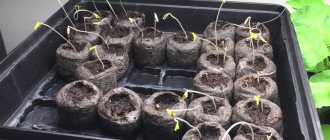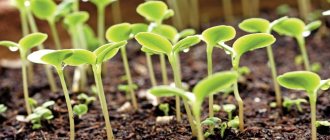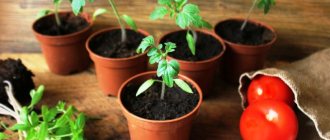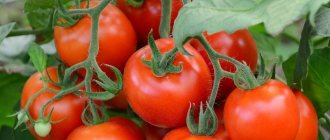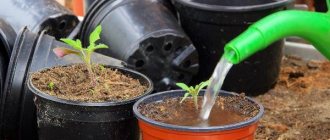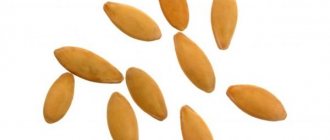Home Vegetable beds
In order to properly prepare for planting, tomato seeds, like the seeds of any other vegetable crops, must undergo pre-treatment. Preparing tomato seeds for planting as seedlings includes such agrotechnical techniques as sorting, testing for germination, pelleting, heating, stratification and soaking. You will learn more about everything from this material.
- 2 Preparing tomato seeds for planting: sorting and checking
- 3 How to properly prepare tomato seeds for planting: panning
- 4 Thermal preparation of tomato seeds for sowing and stratification
- 5 Preparing tomato seeds for planting: soaking
- 6 Scheme for preparing tomato seeds for sowing as seedlings (with video)
How to choose good tomato seeds
The choice of seed must be approached with all responsibility. A few tips will help you purchase quality seeds. Important Recommendations:
- You should only buy goods from trusted sellers or specialized stores.
- It is better to opt for manufacturers that have been proven over the years and have positive reviews from loyal customers.
- It is important to pay attention to expiration dates when purchasing. Expired seed is unlikely to produce a harvest.
- The packaging of a quality product always contains information necessary for a gardener. This is the contact phone number of the producers, the time when it is recommended to plant seedlings in the ground, the expiration date and the time allotted for the full ripening of the crop.
- It is worth giving preference to those varieties that are well adapted to a specific climatic zone.
During preparation, it is important to pay attention to each seed. It should not be damaged, lumpy or infected with disease. The color should be uniform, not too dark and not too light. To finally make sure that the planting material is of high quality, you can conduct the following home test:
- prepare a saline solution from 200 ml of water (warm) and 1 tsp. salt;
- pour out the seeds and stir with a spoon;
- leave for 10 minutes.
After time has passed, conclusions can be drawn. It is better to discard those specimens that float to the surface of the solution, since most likely they will not germinate or will not produce a harvest in the future. But the seeds from the bottom of the glass should be washed with running water and begin processing.
Tips for choosing
Selecting tomato seeds for seedlings is a necessary condition for a good harvest. Different species grow well and produce excellent harvests in different conditions. First, the gardener should decide on the growing location: soil or greenhouse.
The decision depends on place of residence, climate, personal capabilities:
- In the southern regions, tomatoes have time to ripen in the garden beds.
- In the middle zone, ground vegetables are threatened by early frosts.
- In the northern regions, the summer is too short for such a crop.
In the greenhouse
When planning to plant in a greenhouse, you need to select varieties that grow better there. Greenhouse plants mature early. They are less susceptible to infection. They are not afraid of temperature changes. Gardeners want the harvest to be stored for a long time and the fruits to be tasty.
The following varieties fully meet these qualities:
- Bull's heart is a mid-season variety with bushes two meters high. The fruits are large and tasty. Ox heart grows well in film greenhouses and produces an excellent harvest. The species has only one drawback: the fruits are large and cannot be preserved.
- De Barao is a mid-season variety. The height of the trunk is 2 m. The trunk is weak: it needs a garter. The plant has many additional shoots. Requires stepsoning. The small size fruits have a bright red color. Tomatoes are delicious. They are well preserved.
- Königsberg is a mid-season variety. The fruits have an elongated shape. Up to three buckets of fruit are collected from one bush. Tomatoes store well and are suitable for canning.
This is not a complete list of varieties that are grown in greenhouses.
In the ground
Ground species are more difficult to select. The choice depends on the climate. Any tomatoes grow well in the south. In temperate climates, average daily temperatures are lower and the possibility of return frosts is higher. Vegetables for planting must be carefully selected.
Avid gardeners highly appreciate the varieties of tomatoes for planting in garden beds:
- Raspberry ringing F1. This is an early ripening variety. The fruits are pink in color. The variety has high productivity. With proper care, up to 16 kg of delicious ripe fruits can be collected from 1 m2.
- Watercolor. An almost ideal species for planting in garden beds. It was appreciated by gardeners in all regions. The small oval fruits weigh only 55 g. The consistency is dense.
- Moravian miracle. An early-ripening, productive variety that grows well in vegetable gardens. The fruits are round and medium in size. Tomatoes have an attractive appearance. Their skin is smooth and even. The bright red color attracts attention. Delicious both fresh and canned.
You should choose seeds based on what you want to get. You can’t get everything from one variety at once. The solution is to choose several varieties that will fulfill different requirements.
Pickling or disinfection
The seed coat may contain pathogens of some tomato diseases that can infect seedlings, so additional disinfection is necessary.
The seeds are placed in a bright pink solution of potassium permanganate, where they are disinfected for half an hour. They should then be washed and dried.
In addition to potassium permanganate, you can use Fitosporin or other similar drugs, which are diluted according to the instructions.
After the dressing process, adult tomato plants will be less susceptible to diseases.
How to properly prepare seed material for sowing - description of methods
Any “help” to plants should be in moderation. You should not resort to all types of processing at the same time. This will only harm the culture. In addition, if the seeds are healthy, they do not need to be processed at all. The harvest will already be high if you follow the basic rules for growing.
Etching with potassium permanganate
This method of disinfection is considered the simplest, but at the same time effective. Again, only seeds obtained from infected adult crops, or those produced by a dubious manufacturer, need treatment.
- To do this, the seeds are soaked for a quarter of an hour in a 1% solution. It is important that the treatment does not last longer than 20 minutes.
- After soaking, the seed must be washed and dried.
If healthy seeds are soaked, this procedure can only worsen their condition, since it will kill the entire immune system.
We suggest watching a video about soaking tomato seeds in potassium permanganate:
Warming up
This method is another type of disinfection. But such manipulation must be carried out with extreme caution. The heating temperature should not be higher than 40 degrees Celsius, which is very difficult to achieve. Therefore, experienced vegetable growers recommend turning to the old, proven “potassium permanganate”. Some people think that just placing the seeds on a heating device is enough. But this is not so, since such a procedure will only dry out the seed.
If you purchased seeds in a specialized store, then they have already gone through all stages of processing and do not need homemade ones.
Saturation with microelements
This procedure will help improve all the vital characteristics of future plants: resistance to weather conditions and diseases, yield, shelf life, taste.
- In order to enrich tomatoes with nutrients, you need to take a few tablespoons of wood ash and stir it in two glasses of clean water at room temperature.
- The resulting solution should infuse for two days.
- And after that, the seeds are placed in the tincture for 3-4 hours.
Metal cannot be used as a container for ash solution.
Stratification
This procedure involves cooling the seeds in the refrigerator for several hours. But it is not always the case. Professional agronomists cool seeds not for a couple of hours, but for three whole months. However, such manipulation is not suitable for tomatoes. It is best to find a middle ground by leaving the seeds in the cold for 3 to 5 days. At the same time, the air temperature should remain at 3 degrees Celsius.
The seed that is planted in early spring needs stratification the most. It is also necessary to cool old seeds to awaken them.
To carry out this procedure, the seed is placed in damp gauze, and it is placed in the vegetable compartment. You need to make sure that the gauze does not dry out. After 5 days, the material is removed from the refrigerator and they are ready for planting.
Soak
Such manipulation is so familiar to agronomists that no one even thinks about whether it is necessary. Seeds wrapped in gauze are soaked in warm water for several days, depending on the variety. After this, the seed will germinate better and faster. The main thing is not to go too far with time: the point is to prevent the sprouts from intertwining with each other.
The water temperature should be 22-25 degrees Celsius. Adjust the soaking time to the planting time, since immediately after this procedure the seeds need to be planted even without drying.
Important! Do not soak plants that have been treated with chemicals during pre-sale preparation.
From the video you will learn how to properly soak tomato seeds in water:
Epin and other growth stimulants
This manipulation is necessary in order to increase the immunity of young seedlings. Most often the following drugs are used for this: “Sprostok”, “Epin”. The seed is immersed in the solution for a period of half an hour to an hour (the exact time is indicated in the instructions).
Such procedures will awaken the seeds and increase their resistance to diseases.
There is no need to keep the seeds in the stimulator - this will only worsen the condition of the material.
Barbating
Such manipulation is extremely rarely used at home. However, it is very effective. The meaning of the procedure is to place the seeds in water enriched with oxygen. This is where an aquarium compressor comes to the rescue.
This method has the main advantage - the seed material is awakened, but no chemicals are used.
Barbating is often used for rare varieties of seeds that can no longer be found on store shelves, and those that you have have long expired.
Hardening
This procedure is somewhat similar to stratification.
- To do this, the seeds are placed in natural fabric and then in a plastic bag.
- Then the bag is placed in a cold place for a day (for two people).
Such manipulation will make the seed more resistant to illnesses and vagaries of the weather. In addition, such seeds germinate several days earlier.
Important! Immediately after hardening, the seeds must be planted in the prepared soil.
You should not use all of the listed processing methods at once. You just need to choose one or two of them. And sometimes the seed does not need any processing at all.
Treatment with stimulants or nutrient loading
The procedure is carried out a day before disembarkation, not earlier. Stimulants can be purchased at a specialty store or prepared yourself. Maintain the temperature at least +20ºC.
It is recommended to use melt water.
Juice is squeezed out of potatoes or aloe and diluted a little with water. The seeds are placed in one of these nutrient solutions for one day.
Ash solution for enrichment with microelements: 1 tsp. Stir in a glass of hot water and leave for 24 hours. Then the seeds are kept in it for 4-5 hours.
Industrial preparations: Zircon, Epin (1 drop per 1 tbsp.) for 16-18 hours.
Treatment with stimulants is carried out only after disinfection!
After stimulation, the planting material is not washed, but only dried. This procedure promotes rapid and simultaneous germination of seedlings.
Preparing soil and containers for planting
Ready-made soil, which can be purchased at the store, is already prepared and disinfected. If you are going to plant tomato seeds in your soil, it is best to take the soil where acacias grow. It is necessary to remove the top layer to a depth of 5 cm, and then collect soil containing well-rotted leaf litter.
It needs to be harvested in the fall and stored outside or in conditions close to winter conditions (refrigerator, balcony, etc.), avoiding moisture and snow. Before planting, add sand and humus. To be sure that the planted seeds are completely safe, the soil must be disinfected.
There are disinfection methods such as thermal and chemical. One of the most popular - and simplest - methods of soil disinfection is calcination.
But such disinfection has one significant drawback: high temperatures not only kill pathogens - they kill all microflora, not only harmful, but also beneficial.
So, to some extent, such soil can be called scorched earth, in which, for the full development of seedlings from a seed, much more effort and money will need to be invested than in soil that was disinfected by other methods. But if you still decide to calcine the soil, then you need to spread it in an even layer of 5 cm on a baking sheet and put it in the oven for 45-50 minutes, preheated to 100°C.
Another thermal method is freezing. Microorganisms will die if the soil is exposed to temperatures below -10°C. This substrate is brought into the room a day before sowing the seeds.
You can use steam to treat the soil: hold it in a steam bath for half an hour or treat it with special devices for steaming clothes.
The chemical method is good old potassium permanganate: make a solution of a rich purple-pink color in hot water and water the ground with the hot solution.
As for planting containers, you can use both ready-made containers, including substrates, peat tablets and pots, and improvised means.
When preparing a large number of seedlings, it is better to use mini-greenhouses, which are treated with a solution of potassium permanganate before filling with soil.
Clay pots are scalded with hot water; the same can be done with other heat-resistant containers.
But often, ordinary disposable plastic cups or food containers are used for seedlings. Only chemical treatment is suitable for them.
The contents of purchased peat and other similar pots are already ready for planting and do not need disinfection.
Bubbling seeds
Another procedure that improves germination is popular among experienced gardeners - bubbling before planting. Each seed is covered with a protective layer consisting of essential oils. To remove it, oxygen is used, which is supplied directly to the water. If you have an aquarium, you can use a compressor to supply air from it. Place the seeds in water and wait until they settle to the bottom. Then open the air supply to the water so that bubbling occurs, that is, bubbles form. Keep the seed in these conditions for about 20-30 minutes. Awakening the seeds
When the tomato seeds are almost ready for planting, they need to be activated - awakened. Pre-awakened seeds germinate earlier than usual by 5-8 days. There are several methods of awakening:
- Place the seeds on damp gauze, cover with another damp layer of gauze and leave to germinate for 1-2 days. Over time, the protective shell cracks and small sprouts appear;
- soak the seeds in melt water for several hours. Melt water has superior properties to ordinary water and has a unique structure, which helps to achieve excellent yield and early ripening in growing tomatoes;
- Aloe juice is added to the water (4-5 drops per 1 liter), and then the seeds are immersed in it for 20-30 minutes. Aloe juice helps the seed to activate and also has an antibacterial effect;
- the grains are poured onto gauze, and then a bag is formed from it. The bag is alternately immersed in cold and then hot water. Under the temperature difference, the protective shell cracks, which ensures early germination of seedlings.
Seed awakening is especially important for late-ripening varieties and for varieties intended for outdoor cultivation.
How to properly collect the material yourself?
Many gardeners do not bother themselves with collecting seeds from their own harvest and buy ready-made seed in the store, but in vain. After all, homemade seeds have a number of advantages over store-bought ones :
- seeds collected by hand have better germination;
- homemade seeds are larger in size;
- seedlings from home seeds are more resistant to disease;
- seedling yield is higher.
How to prepare tomato seeds for sowing? This procedure is quite simple:
- Select the desired tomato variety to extract the seeds.
- We select large and abundantly fruiting tomato bushes.
- We are waiting for the tomato to fully ripen: we pick the fruit and place it in a dry, warm place, for example, on a windowsill (for about 14 days).
- When the fruits become soft, you can begin to extract the seeds.
- Cut the tomato in half and scoop out all the pulp with a teaspoon.
- To separate the seeds well, place the pulp in a container of water.
- After this, we wash the seeds, dry them with a paper towel or newspaper, and place them in small bags.
Advice. For convenience, the bags can be signed, indicating the date of packaging and grade.Next, you can watch a video on how to collect and prepare tomato seeds yourself:
Preparing hybrid tomato seeds
Hybrid varieties of tomatoes initially have excellent immune qualities and germinate quickly, which greatly simplifies their cultivation. Before planting, the seeds do not need to be calcined and soaked in growth stimulants, since the seed germination rate is initially high. Most hybrid varieties have a germination rate of 95% or even higher; conventional tomato varieties cannot boast of such high results. Agronomists do not allow disinfection of hybrids, and seed producers assure them of their high quality. In fact, hybrid varieties are initially prepared for planting; they only need to be sown in fertile soil and wait for the formation of young sprouts within a week.
What is the best way to use folk methods?
We have listed professional methods, but there are many folk methods of treatment. every agronomist wants to share his method. Let's name the most popular and time-tested by many vegetable growers.
Aloe juice
Aloe juice is a folk growth stimulant. This solution has a number of advantages:
- efficiency;
- environmental friendliness;
- cheapness.
To prepare the juice you need:
- Cut a leaf from the plant.
- Wrap in gauze and place in the refrigerator (never in the freezer).
- During a week of staying in the cold, the leaves will infuse and the biologically active substances will be activated.
- After seven days, the leaves are crushed in a blender to a pulp.
- After this, pure juice is squeezed out of the pulp, which is then diluted with water in a 1:1 ratio.
This procedure is most necessary for old plants. Leave the seed in the solution for a day.
Hydrogen peroxide
This solution is necessary to stimulate the growth of seed. It is prepared as follows:
- 40 ml of 3% peroxide are dissolved in 500 ml of clean water.
- Tomato seeds are left in the tincture for 24 hours.
In baking soda
- 10 grams of soda are diluted in a liter of water.
- The seeds are placed in the resulting solution for a day.
succinic acid
The tincture is a good growth stimulant. To do this, 15 grams of acid are dissolved in a liter of clean water at room temperature. Soaking time - 24 hours.
Mustard
This solution helps destroy bacteria and microbes existing in the seeds.
- For one liter of water you need to take mustard powder on the tip of a knife.
- Leave the seed in the solution for 6 hours.
- After the specified time, the seeds are dried without prior washing.
Treating seeds before planting does not at all guarantee that the seed will sprout quickly or the seedlings will be healthy. Much also depends on the quality of the seeds. However, one of the processing procedures described above is still worth carrying out - it will only benefit your entire harvest.
How to properly germinate tomato seeds
To speed up the production of healthy and strong seedlings, I advise you to always germinate the seeds.
- If the seeds are fresh, then you can use the simplest method of germination - place the seeds on damp gauze placed on a plate.
- A plate with seeds can be placed on a table in a regular living room and periodically checked to see if the gauze has dried out. As soon as the seeds hatch, they can be sown.
- If the seeds are old or have an unclear expiration date, then I advise you to germinate them not in ordinary water, but in water with the addition of any growth stimulant, purchased or prepared at home. For example, soak the seeds in aloe juice or potato juice diluted by half.
An even more reliable result will be obtained by soaking in a microelement complex, for example Aquamix from the Buysky chemical plant. Concentrated fertilizer is diluted in water (1 ml per 150 ml of water) and the seeds are soaked for 8-12 hours before planting. As a result, the germination of the seeds increases, they receive the necessary nutrition and protection from chlorosis.
How to calculate the timing of planting tomato seedlings
There is a formula that allows you to calculate when to bookmark. It looks like this: A=BCD.
In this formula:
- A – sowing tomato seeds for seedlings;
- B – day of transplanting into the ground;
- C – period of seedling growth at home;
- D – number of days allotted for pre-planting treatment, soaking of tomato seeds, pipping.
For example, consider mid-season tomatoes, which are planted in beds in the middle zone of the country:
- treatment of tomato seeds before planting and germination – 3 days;
- time until first shoots – maximum 10 days;
- picking and recovery – 10 days;
- The growth period of a mid-season variety is 60 days.
The total is 83 days. This means that you need to sow 2.5 months before transplanting into the ground. In central Russia, this period falls on the second ten days of March.
To determine the timing of planting tomatoes for sowing seedlings, just carefully read the instructions on the package. Manufacturers provide detailed recommendations on timing.
Adherents of correlating gardening work with the phases of the Moon should purchase the Gardener's Handbook. It describes favorable days for sowing seedlings of tomatoes and peppers. There you can also learn how to prepare seeds for planting according to Feng Shui.
Preparations and home remedies for pre-treatment of tomato seeds before sowing
There are many processing methods: folk remedies, pharmaceutical remedies, as well as special-purpose preparations.
Hydrogen peroxide
Peroxide is used both to accelerate germination and for disinfection. For this, use a 3% solution. Dilute 1 tbsp in 0.5 liters of water. peroxide, and put the seeds there for 24 hours. Then rinse them and dry them.
Iodine etching
Medical iodine is used to fertilize garden crops. Thanks to its antiseptic properties, it is possible to improve the process of nitrogen exchange in the soil, kill bacteria and rot. Advantages of the drug:
- improves the taste, color and size of tomatoes;
- increases productivity;
- increases the concentration of vitamin C.
From late blight
It is necessary to treat seeds with iodine to ensure their viability and protection from late blight. To obtain a solution, just 1 drop of the drug per 1 liter of water is enough. Before sowing, you need to soak the seeds for 2-3 hours, and then put it in the refrigerator. Is it possible to freeze leeks and leeks for the winter? Read here.
Using ammonia or ammonia
This drug is used in various ways: to stimulate growth, protect against parasites and improve plant survival.
To stimulate growth
Dissolve 10 ml of 10% ammonia in 10 liters of water. Add 10 ml of apple cider vinegar and 10 g of laundry soap, previously ground on a grater. Mix everything thoroughly, pour the solution into a container with a spray bottle and spray the future fruits.
From pests
To protect the plant from parasites, you need to combine 10 liters of water, 10 g of crushed laundry soap and 10 ml of ammonia. After thorough mixing, all affected plants should be treated with the solution.
For adaptation
In order for tomatoes to withstand bad weather, you need to dilute 3 tbsp in 10 liters of water. ammonia. This amount is enough to process one bush.
Fitosporin for treating soil and seeds against diseases
This preparation for tomatoes is diluted 2 times. The first time is to obtain a concentrate, and the second time is to obtain a working solution.
To prepare the concentrate, you need:
- Dissolve 200 g of product in 400 ml of warm water.
- The water temperature should be room temperature.
Dilution in this proportion is also suitable for a working solution with a sufficient number of active bacteria.
Preparation of the working solution has its own characteristics:
- To treat the soil before sowing - 1 liter of water and 1 tsp. concentrate.
- To treat tomato seeds – 200 ml of water and 4 drops of concentrate.
- To treat roots when picking – 200 ml of water and 4 drops of concentrate.
To treat plants in a greenhouse, you can take 1.5 tbsp. concentrate and 10 liters of water. Find out how to grow onions in a greenhouse in winter in this article.
Soda for late blight and aphids
This solution repels pests due to the pungent odor of garlic.
For preparation you need the following components:
- garlic – 200 g;
- soda – 2 tbsp;
- soap – 100 g;
- water – 10 l.
Procedure:
- Grind the soap and garlic.
- Mix all ingredients and mix thoroughly.
- Leave the product for 6 hours and then use it to spray garden crops.
Trichopolum
This is an antibacterial drug and is a derivative of nitromidazole. Using this remedy you can not only get rid of late blight, but also:
- Powdery mildew. This is a fungal disease that is transmitted to tomatoes through water and air.
- Fusarium. Infection occurs through the soil. The root system is affected first, and then the stems. The diseased plant dies.
- Angular spotting. This is a bacterial disease that leads to the death of tomatoes.
- Bacterial cancer. This is a very dangerous disease for tomatoes, and the main source of infection is the seeds.
To prepare the solution, you need to crush 15 tablets of the drug, dissolve in 10 liters of water and add 1 bottle of iodine. The resulting product can be sprayed on tomatoes.
Boiling water
Procedure:
- The soil into which you plan to send the seeds needs to be poured with boiling water.
- Next, lay the planting material and cover it with a plastic bag on top. This will create a bath effect, which will activate the growth and development of young plants.
- Polyethylene can be removed only after the seeds have fully germinated.
This method allows you to disinfect planting material from harmful bacteria and insect eggs.
And although this method is considered very effective, under the influence of hot water the structure of the seeds changes. So it is unknown how they will grow in the future.
For maximum survival rate, the seed must be treated with special preparations. Kornevin or gummate fertilizers are suitable. They will increase the rate of growth and development of the root system.
Boric acid
To speed up the growth and development of Beef tomatoes, as well as other varieties, and increase the germination of seeds, they need to be soaked in a solution of boric acid. To do this, dissolve 0.2 g of the drug in 1 liter of warm water. Place the seeds in the solution and leave for 12-24 hours. To prevent the grains from floating when soaking, they need to be placed in a gauze bag.
With a lack of boron in tomatoes, blackening and death of the growth point of the stem occurs, active growth of new shoots from the root, while the petioles of young leaves will be very brittle.
Vitamins and growth stimulants
Thanks to these drugs, it is possible to activate the growth of garden crops, increase its immunity, and protect it from diseases and negative weather conditions.
Heteroauxin
This is one of the most powerful growth stimulants. This is both an advantage and a disadvantage, since even the slightest overdose can lead to the opposite effect. Before planting, tomato seeds should be placed in a 0.01% solution for 4-6 hours. To prepare it, you need to crush 1 tablet of the drug and dissolve it in 1 liter of water.
Cost - from 38 rubles.
Silk - how to use correctly according to instructions
Using this stimulant, the yield of tomatoes will be much higher than that of untreated vegetable crops. In addition, the treated bushes will be able to withstand temperature changes and will receive lasting immunity to viral and fungal pathologies.
To soak the seeds, you need to prepare a working solution by dissolving the required amount of the drug in 200 ml of water (it depends on the form of the drug).
Seed processing is carried out in 2 ways:
- Soak the planting material in the prepared solution for 2 hours.
- The seeds are sprayed and dried.
Aspirin
Tablets of this drug have the following effects on planting material:
- disinfect;
- stimulate germination;
- improve germination.
First, dissolve the tablet in 200 ml of water, and then increase the amount of the finished solution to 1 liter. Soak the seeds for 12 hours before sowing. The solution is also suitable for watering the soil in which tomatoes are to be grown.
Spraying
Planting material can be prepared for planting not only by soaking, but also by spraying. Special preparations are used for this.
Trichopolum
This product allows you to create a strong immune system to resist pests. The peculiarity of the drug is its bitter taste. To prepare the solution you will need the following components:
- tablets – 15 pcs.;
- iodine – 1 bottle;
- water – 10 l.
Cost - 79 rubles.
Procedure:
- Crush the tablets, add water and mix thoroughly. Add iodine.
- Spread the seeds on a cloth and spray with the resulting solution.
- Transfer to dry gauze and wait for the planting material to dry completely.
Urea to prevent stretching
This product is suitable for use as a main and auxiliary fertilizer. For tomatoes, urea is used according to the following scheme:
- Add 5-12 g per 1 m2 to the soil before planting.
- During the growing season, pour 1 liter of solution under each bush (20-30 g of the drug per 10 liters of water).
- Feeding the plant by spraying is done using a working solution. For 10 liters of water there is 50 g of product. But the product is used in more limited quantities. 3 liters of solution is enough to treat 300 m2.
Treatment with urea should be performed infrequently and in small doses.
It is advisable to water the seedlings generously 2 hours before spraying.
Disease Control
The disinfection procedure is necessary to get rid of all pathogens that live on the seed shell. The most common recipes include potassium permanganate and hydrogen peroxide.
- How to treat tomato seeds with hydrogen peroxide? For two days, you can soak the seeds in 10% hydrogen peroxide to achieve a disinfecting effect. The amount of active ingredient must be equal to the number of seeds. A solution with hydrogen peroxide reduces the nitrate content in fruits, increases the germination rate, and strengthens the immune system. In addition, it helps to disinfect the surface of each grain, which often contains germs and fungi in a dormant state.
- Gardeners often use the biological preparation Fitolavin when growing tomatoes on their own. The composition based on streptothricin antibiotics prevents the development of the most common diseases among tomatoes. The drug is absolutely safe for humans and does not affect beneficial soil flora.
- Thermal disinfection has been popular since ancient times. The method allows you to get rid of harmful microbes and increase productivity. For this purpose, a place will be organized for planting material within two days where the air temperature will be about 30-50 degrees.
If you start fighting bacteria and fungi at this stage, then in the future the green bushes will be able to independently fight the invasion of pathogenic bacteria.
